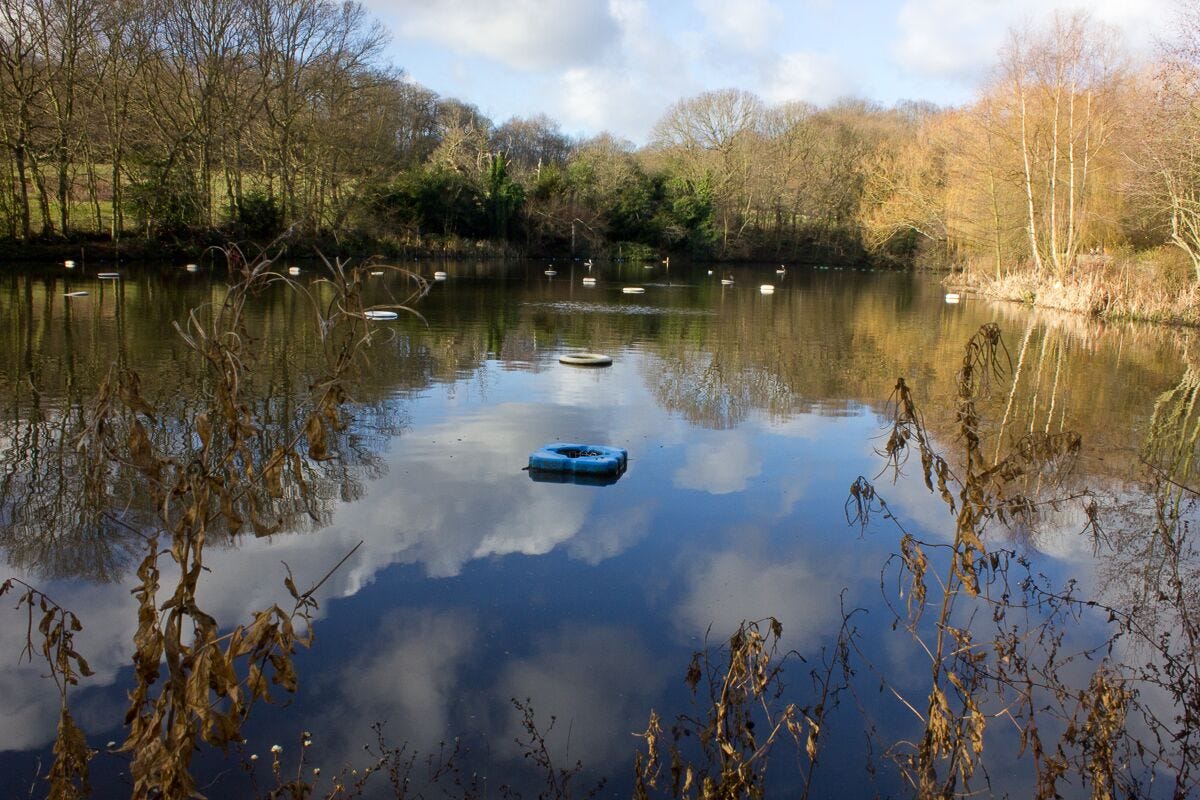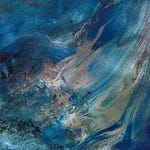Photo from the Kenwood Ladies Pond Association
Dear Reader,
How are you? I’m writing this after a day of re-wilding my being. I’ve immersed myself in the Ladies’ Pond, on Hampstead Heath - it was way too cold to do much swimming! I’ve walked for miles in the mud and marsh. I’ve tasted primrose and dandelion flowers; garlic mustard and ground elder leaves. I’ve sat awestruck amongst a council of wise, lichen and moss enrobed, tree beings. I’ve contemplated insects, spied on rats, disturbed squirrels at play, gazed at a heron sunning herself… I’ve inhaled the fragrance of blossoms, witnessed the first bluebells and been serenaded by the spring chorus.
I love that feeling of having spent the whole day outdoors. My senses have been satiated, stimulated and soothed by a plethora of juicy, sparkling fresh green notes, colours and textures. My heart is light, my eyes are soft, and my mind is peaceful. It is true, my body aches a little from around four or five hours of walking, and about the same amount of time just sitting, surrounded by Nature. That is what asana practice is for. It helps us recover from sitting, walking or standing for longer than usual. The gathering of the fascial tension in my legs and hips is already unwinding after some legs up the wall (vipariti karani), some eye of the needle (sucirandhrasana) and butterfly pose (baddhakonasana).
This week we are looking at the utterly fascinating and confounding subject of consciousness. Yoga philosophy is quite precise in its descriptions of consciousness, whereas Western philosophy flounders somewhat. In yoga philosophy, our witness consciousness is called the Atman. This translates best into English as the Self. Atman describes our individuated consciousness, which is inherently a part of the Universal Consciousness, Brahman.
In the Samkhya philosophy, from which classical yoga philosophy is derived, both Atman and Brahman can be described as Purusha. This term denotes all Consciousness everywhere in the Universe. Samkhya philosophy views Purusha as the ultimate nature of reality, unchanging and eternal.
Matter, on the other hand, is called prakriti. This term denotes not only materially solid things, but also things we can’t see, but can describe in terms of their qualities (gunas) such as thoughts, feelings, atmospheres, tastes, smells, sounds, wisdom and bliss. The hugely diverse elements of prakriti are all in constant change, they’re impermanent. This expansive view of matter is different to Western philosophical approaches.
For example, a feeling that is warm and fuzzy is not a state of consciousness in Samkhya philosophy. Our consciousness is viewed as an unchanging witness to the experience of that feeling within the field of prakriti. The effect of the feeling (warm and fuzzy) is not felt within Consciousness itself, but within the panchamayakosha, those five layers of the field of our being that are part of prakriti.
Samkhya philosophy aims to achieve liberation (moksha) through the realisation of purusha so that we may identify with pure consciousness as our true Self - Atman. This frees us from identifying with the panchamayakosha. These koshas form the transitory “illusion” of the way we look, the way we feel, our energy level, our belief system etc. In this way, we can be freed from these false identifications, (avidya) which lead to the all too familiar sufferings and fears associated with a limited egoic view.
The path to this goal is the eight limbs described by Patanjali. These are: yama and niyama, (ethical precepts); pranayama (breath practice); asana (physical practice); and the four stages of meditation - pratyahara (withdrawal of the senses inwards); dharana (focus); dhyana (contemplation) and Samadhi (Self-realisation). This path makes use of rational analysis (jyana yoga) and the development of discrimination (buddhi).
Another approach to the two fundamental forces of the Universe is offered in Hindu thought. Shiva and Shakti are often seen as complementary aspects of the ultimate reality, representing the masculine and feminine principles of consciousness and energy, respectively. Shiva is associated with pure consciousness or awareness, while Shakti is associated with creative energy or power.
Yet in Samkhya philosophy, there is a bias towards the male principle. However, a paradigm shift is happening throughout the world, towards bringing the Divine Feminine and the Divine Masculine back into balance. Interestingly, this is reflected in our culture, developments in science and also within the world of yoga. For instance, the ashram I visit has, over the last decade begun to embrace Divine Feminine teachings in addition to Classical yoga teachings.
Even within classical yoga teachings, it is understood that Prakriti and Purusha are not separate but entwined in divine union. Matter and consciousness are like two sides of the same coin, one cannot exist without the other. The latest advances in modern physics and neuroscience are also coming to these same conclusions. If you are interested, below is a fascinating talk about the current understanding of matter and consciousness, with Ian McGilchrist author of the great tome (which I haven’t read yet) The Matter with Things: Our Brains, Our Delusions, and the Unmaking of the World. This is a huge survey on the nature of reality and consciousness, written from the point of view of a highly educated, polymath who has also worked, as a psychiatrist, with people who’ve suffered from brain injuries and strokes.
So, as discussed by Iain and Alex in this talk, modern physics and neuroscience are coming to the understanding that Prakriti provides the material basis for all experience, while Purusha provides the awareness that makes experience possible. Samkya philosophy approaches the nature of reality via consciousness, attempting to separate it from manifest reality by accessing deep meditative states. This is a challenging path for most people. That said, in my own experience, simply learning this worldview has brought me a sense of peace and understanding of myself and others. This way of viewing the world has helped me enormously in my journey in life, even though I am far from self-realised!!
The Samkhya path to attaining liberation through realising Consciousness as the true nature of reality is not the only one. There is another current of yoga teaching, until recently, little known or understood. This worldview is known as Tantra, this path views each and every part of the manifest world around and within us, as imbued with Divine Consciousness. As you might imagine, as someone who can spend hours being guided by animal spirits, communing with trees and seeking wisdom from weeds Tantra resonates with me deeply. We’ll explore it more the week after next.
Next week I have my yoga therapy training so, it will be a shorter blog. I will have to think of a lighter topic than the Tantric Worldview!
The new term starts this week. Holistic Yoga classes are running, as usual. You can book the classes by using the button below. All are welcome, whether you are a newbie or a regular; whether a Crouch End local or living in another country. You can select your timezone in the booking app so you will get reminders in your own timezone.
Here are the class times and days:
Monday Free Meditation 8-8:30 am GMT on Zoom
Monday 1:30 - 3 pm Holistic Somatics Union Church, Crouch End
Tuesday 6:30-8 pm GMT Holistic Somatics on Zoom.
With love and good wishes,
Julia xx












Share this post